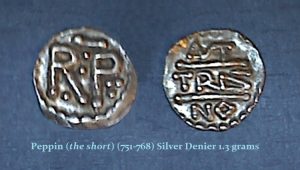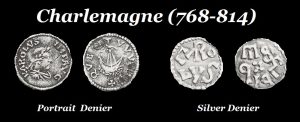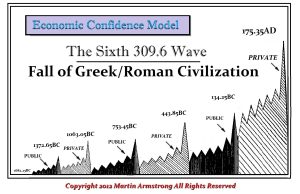Charlemagne, Vikings & Global Warming
QUESTION: Would u care to comment on after the Roman Empire fell, and how the franks a collection of tribes given there own area Holland in today’s terms then eventually taking over Europe to be broken up in to, Four after the main franks king died and split it between four sons. It later all deteriorated , but what of the royal blood line and how does in come on to play with today’s world wide royal blood lines. And if that rise and fall has any premises of what we may face in the next wave , from the ashes. ( tribal small communities ) And were there any coins issued by the franks or his death and the splitting in to four.And are there any links to the franks from the crusades .
As always thank you and your team for providing The knowledge , the whole world needs to understand and start the discussion, on so many up and coming life changing scenarios.
SF
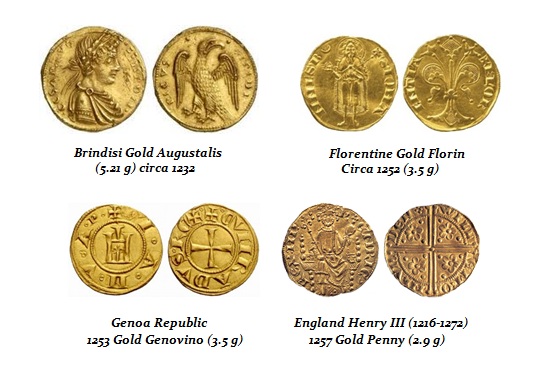
ANSWER: The rise of Charlemagne came 309.6 years from the fall of Rome in 476AD. What is never discussed in the history books is the correlation with weather. Both the rise of the Vikings and the Franks coincided with the Medieval Warm Period (800–1300) and ended with the start of the Little Ice Age (about 1250–1850). It was at the end of this Global Warming period that we find the reappearance of gold coinage. The climate directly influenced the rise and fall of the Vikings. Moreover, we now know that they established a settlement for a while in America about 500 years before Columbus.
Climate was warm and fairly stable pre-180AD which reduced the threat of volcanic winters. There was an exceptionally low level of volcanic activity which also prevailed from c. 40BC to 150AD. We have similarly experienced post-1850 in modern times a warming period with low volcanic activity.
In central Greenland, temperatures became quite warm from c. 20BC to c. 75AD. Global Cooling began in Greenland post 75AD producing a gradual relatively cool period from about c. 100 to c. 270AD. As climate began to turn colder in the northern regions of Europe, this prompted the barbarian invasions into Southern Europe which was dominated by the Roman Empire. Indeed, it was Emperor Aurelian (270-275AD) who had to build the wall around Rome for the first time. There is a lot of climate evidence that confirms the rise of the Roman Empire which peaked 180AD, coincided with a Global Warming period which peaked about 150AD.(1)
Clearly, the climate was turning much colder inspiring the barbarian invasions from the north. As the solar activity turned down, volcanic activity began to rise. The Byzantine historian Procopius wrote: “For the sun gave forth its light without brightness, like the moon, during the whole year.” Temperatures in the summer plummeted creating the coldest decade in the past 2300 years. Snow fell as far east as China during the summer causing starvation as crops failed. The Irish chronicles recorded that “a failure of bread from the years 536–539” took place.
The mysterious clouds which engulfed the world contributed to the era being called the Dark Ages in Western Europe. From a Swiss glacier, ice core samples were obtained at the Climate Change Institute of The University of Maine. They determined that a cataclysmic volcanic eruption in Iceland spewed ash across the Northern Hemisphere during early in 536AD. Two other massive eruptions followed in subsequent years during 540AD and again during 547AD. What appears to have been three successive major volcanic eruptions, the Dark Ages entered a volcanic winter which plunged Europe into famine which lasted for nearly 100 years into 640AD. This was also solar minimum which seems to correlate to an increase in volcanic activity.
With famine comes lower nutrition leaving the people more susceptible to disease. It appears that following the 546AD eruption, we then see the Justinian Plague (541-542AD) which was a bubonic plague, involving Yersinia pestis, which struck the Roman port of Pelusium, in Egypt. This plague spread rapidly throughout the Empire wiping out one-third to one-half of the entire population of the Eastern Roman Empire.
Therefore, because of Global Cooling, crops fail and disease rises. Civilization breaks down and trade ceases. The major solar cycle is about 300 years. Therefore, the rise of Charlemagne came 309.6 years from the fall of Rome in 476AD and it was the fall of Rome which corresponded to the climate turning colder post-150AD.
Charlemagne was the eldest son of Pepin the Short and Bertrada of Laon, born before their canonical marriage which was when a priest witnessed the marriage contract and there had to be two witnesses. The marriage contract was important for all inheritance of property centered on this contract. There were also “temporary marriages” which meant it was invalid insofar as the right to a throne would be denied the offspring of a temporary marriage. Therefore, inheritance would only follow a canonical marriage. The coinage of Pepin the Short begins the reemergence of a denier (old Roman denarius) but it lacked any portrait.
Upon the death of Pepin, Charlemagne became king in 768 of the Franks initially as co-ruler with his brother Carloman I. However, Carloman suddenly died unexpectedly and unexplained in December 771 leaving Charlemagne as the sole ruler of the Frankish Kingdom. He then began to expand his empire conquering tribes. He became the King of the Lombards in 774, and then Emperor of the Romans from 800AD.
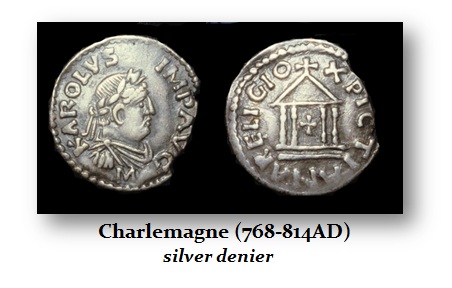
It was Charlemagne who reintroduced his portrait onto the coinage in Continental Europe. Charlemagne united the majority of western and central Europe attempting to reestablish his dream to resurrect the Roman Empire. He was the first recognized emperor to rule from western Europe after the fall of the western half of the Roman Empire. The expanded Frankish state that Charlemagne founded is called the Carolingian Empire which became the Holy Roman Empire.
As the climate warmed, the Vikings also grew in power and were able to explore even reaching America. Their invasion of England was like the barbarians invading Rome. According to the Annals of Ulster, the sack of the Holy Island of Lindisfarne in 793/794, which is a tidal island off the northeast coast of England, marked the beginning of the Viking Age. This event also coincided with Charlemagne’s (768-814) Saxon War, which was a Christian war against the Pagans in Saxony. The Viking attacks may have actually been a response to the spread of Christianity among Pagans since it coincides with the reign of Charlemagne and the attempt to spread Christianity into Scandinavia. The Vikings may have invaded England because of the attacks by the Franks trying to move northward.
Charlemagne’s empire indeed broke apart much as was the case with the collapse of Alexander the Great’s Empire which was divided among his generals. Even NASA is forecasting that the next solar cycle will be the lowest in hundreds of years. If we see the continued rise in volcanic activity, then there is a serious threat of a prolonged Global Cooling which may explain the computer projection for 2032 being the culmination of the Sixth Wave. What is clear, has been the fact that Climate Change people are blaming everything on the Industrial Revolution. They seek to reduce population and to reverse the economic growth of society. They have achieved much of their goals in Europe with excessive regulation and even the ECB claiming it needs to protect society from Climate Change. All of these regulations fighting against a natural trend in nature will contribute greatly to the fall of Europe rather profoundly and its ultimate breakup for the culmination of 2032.


